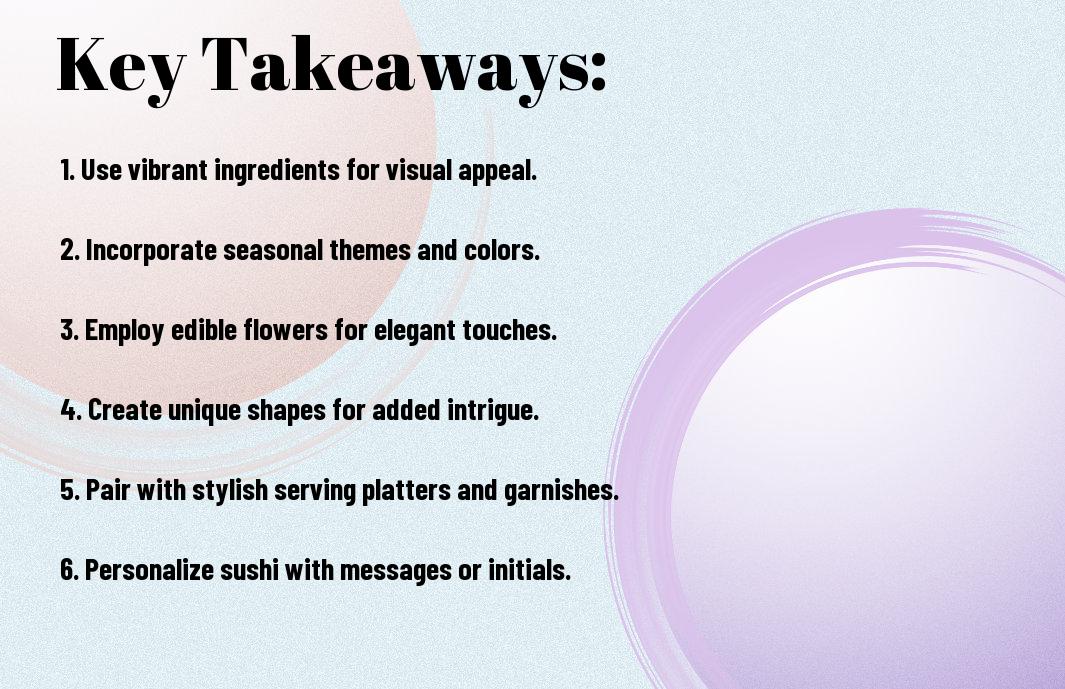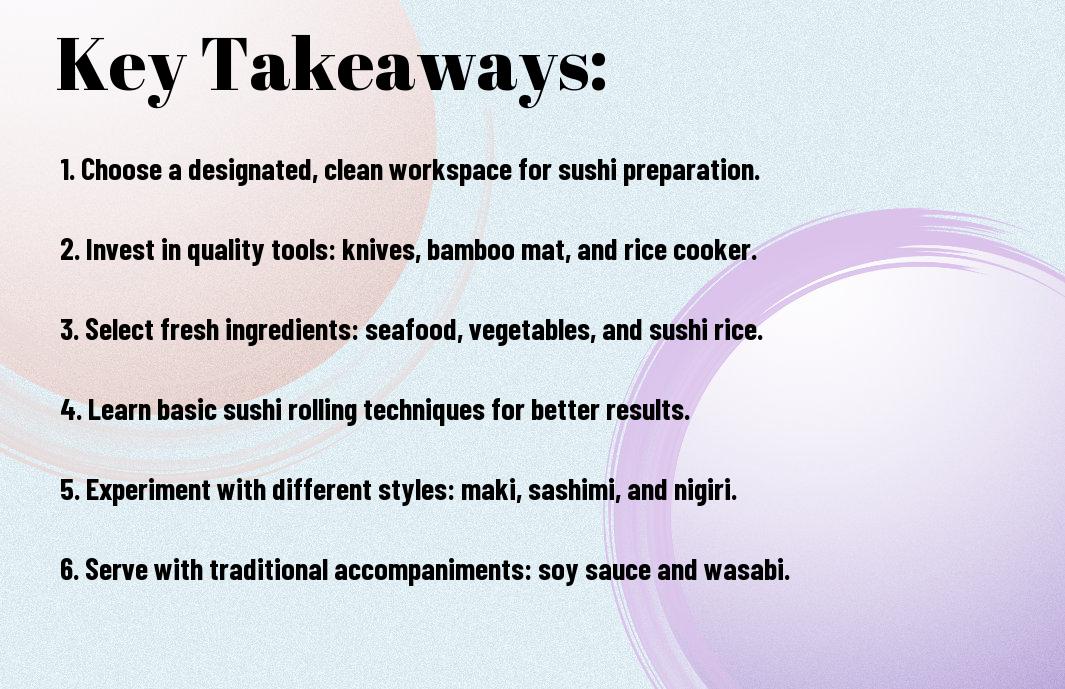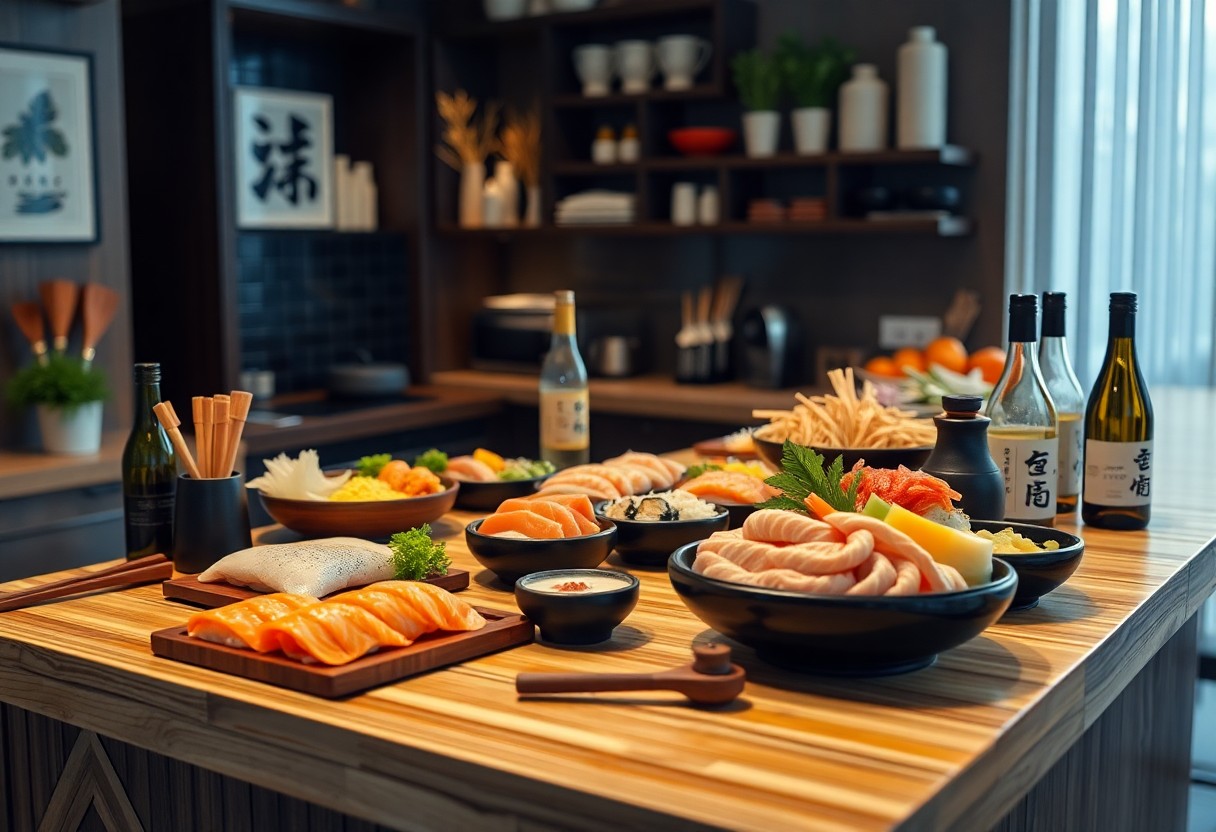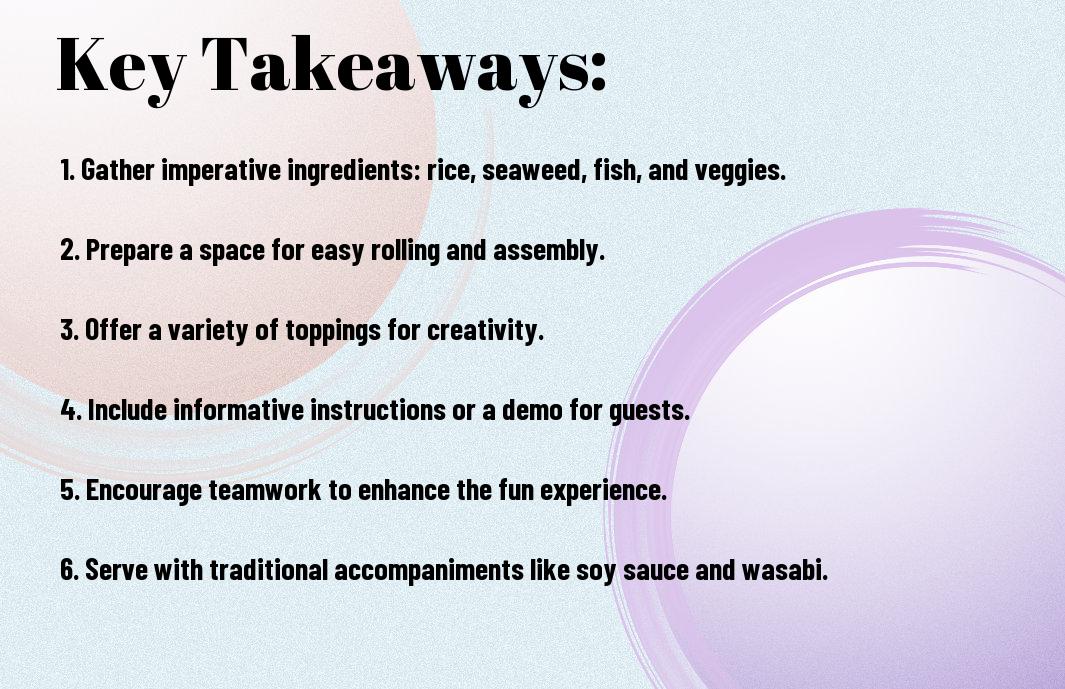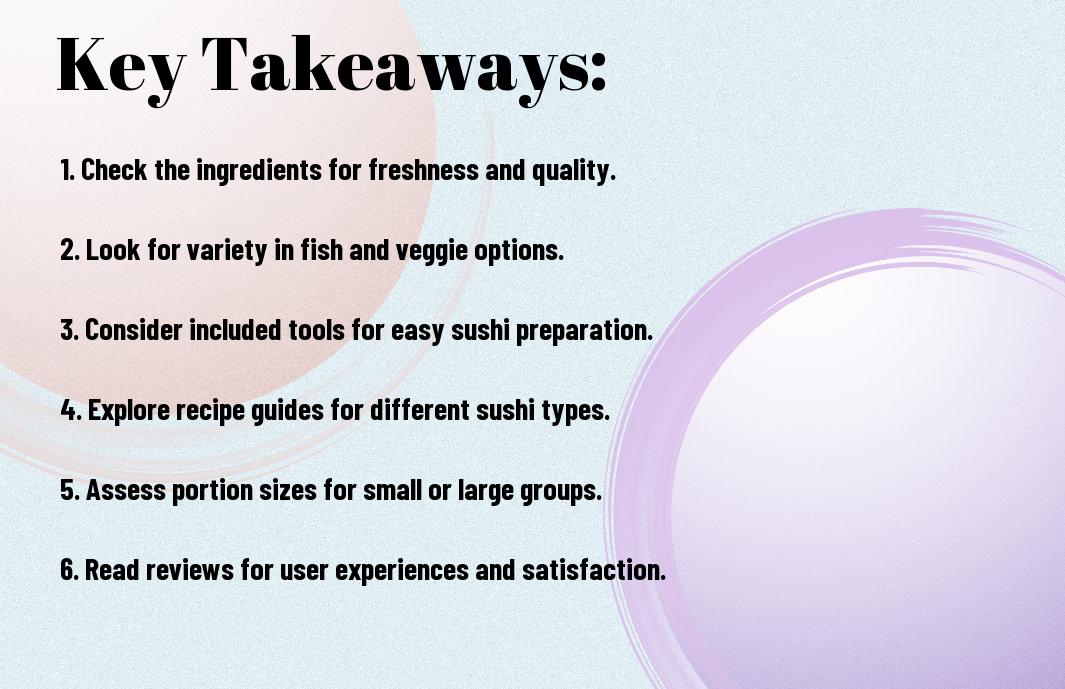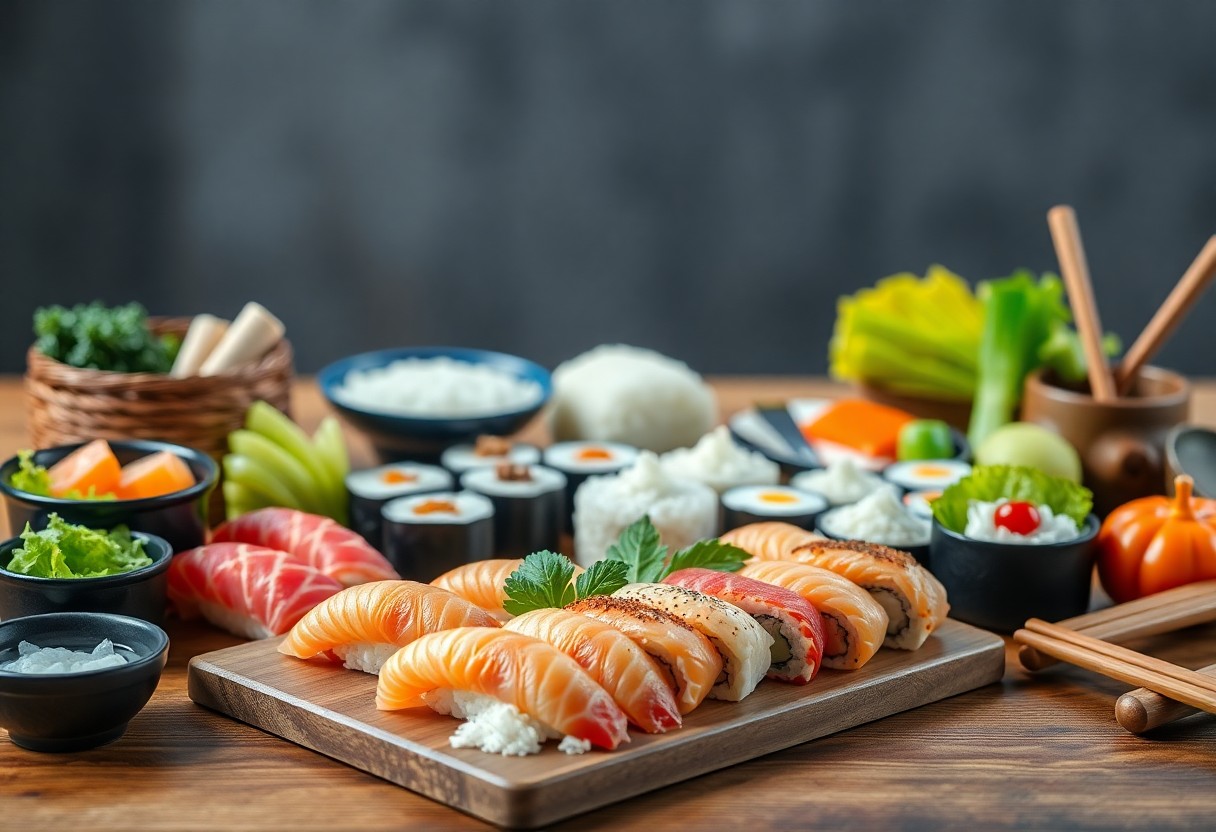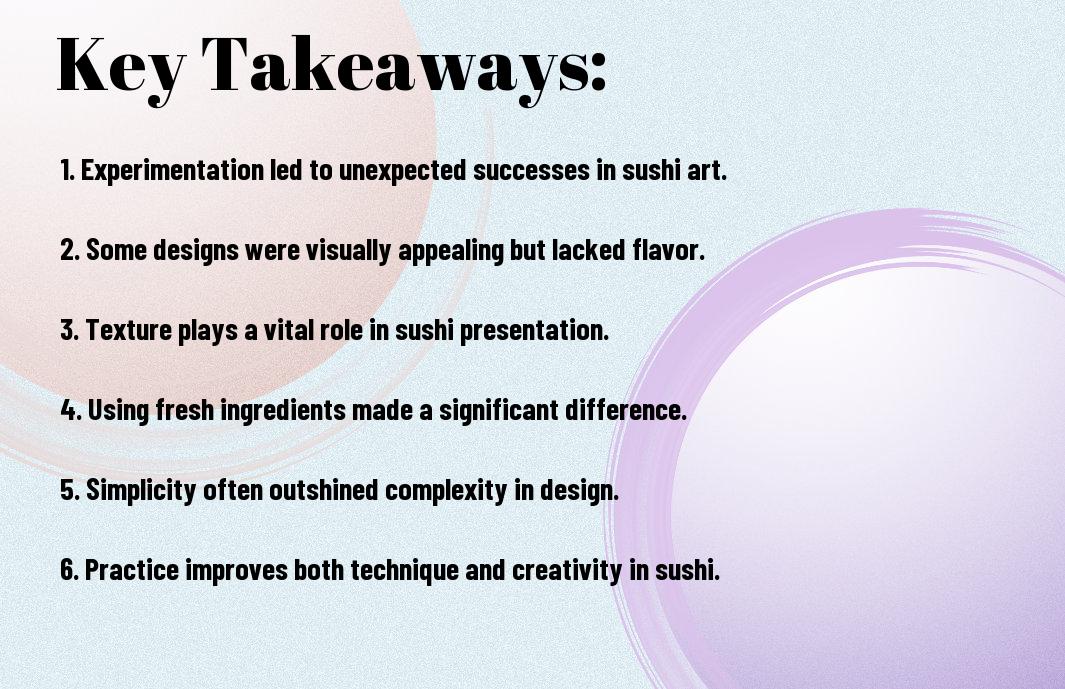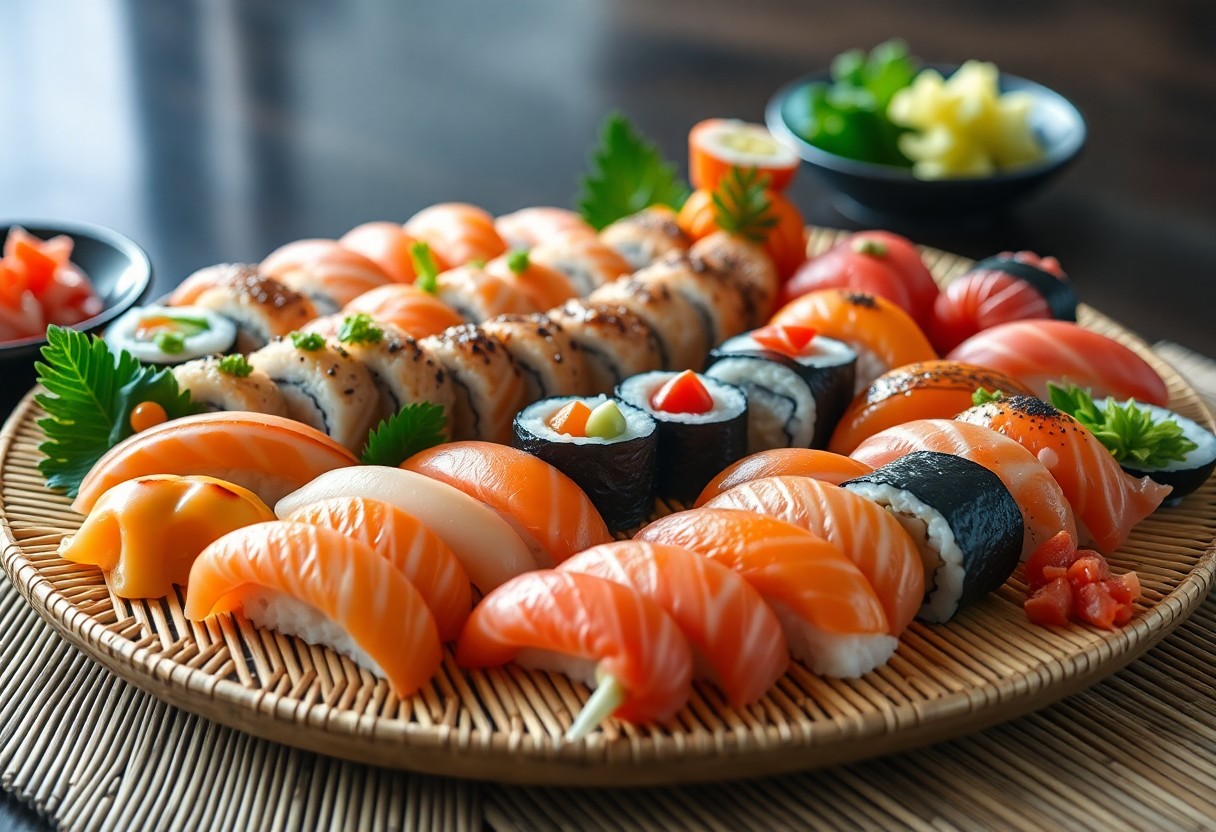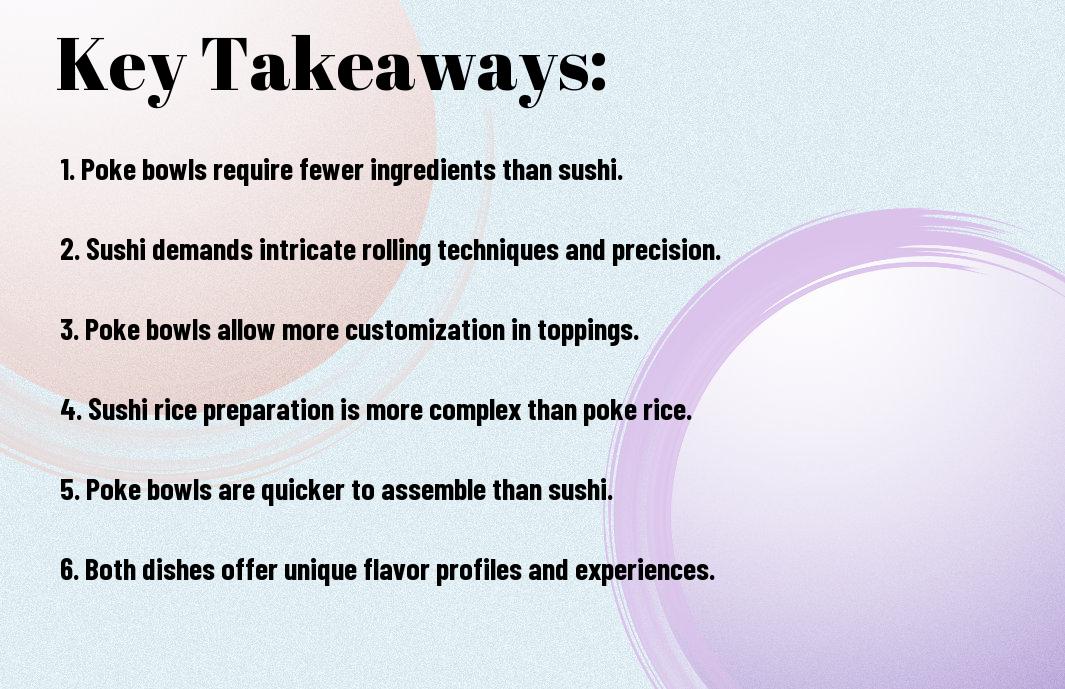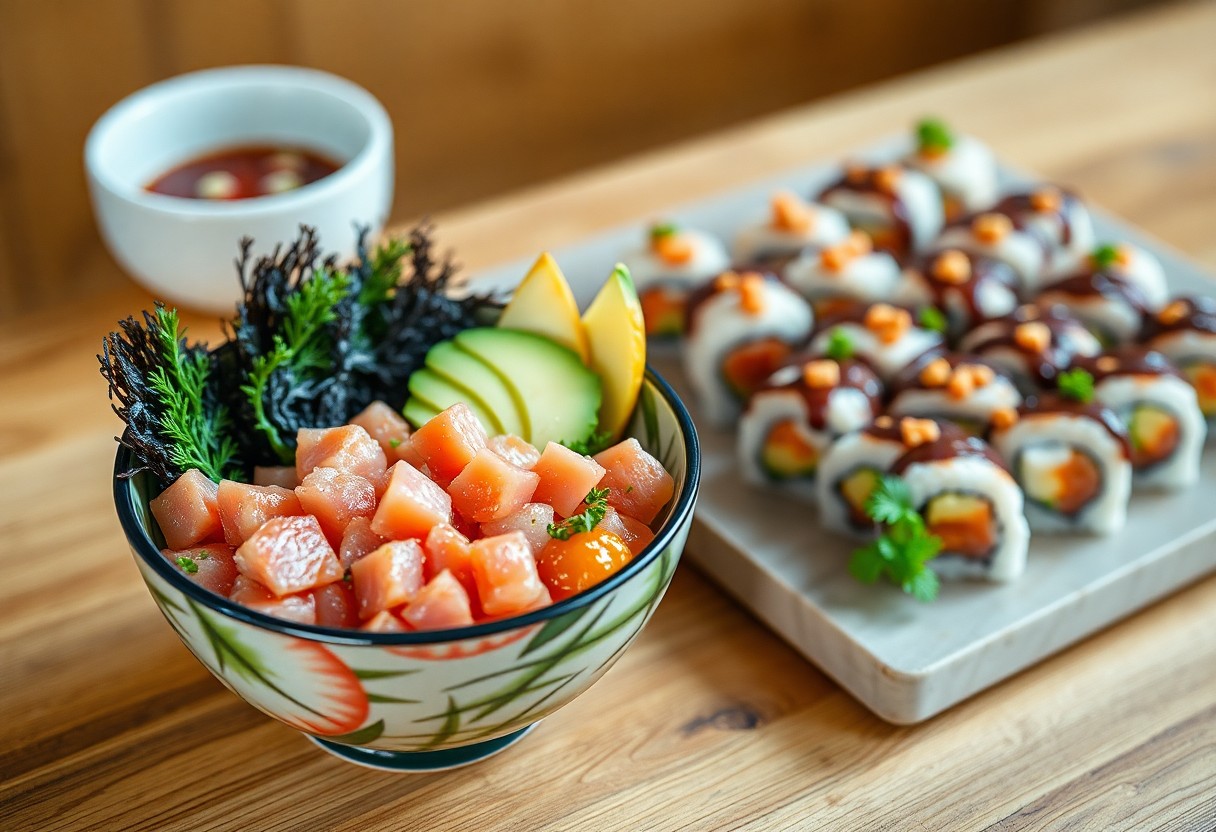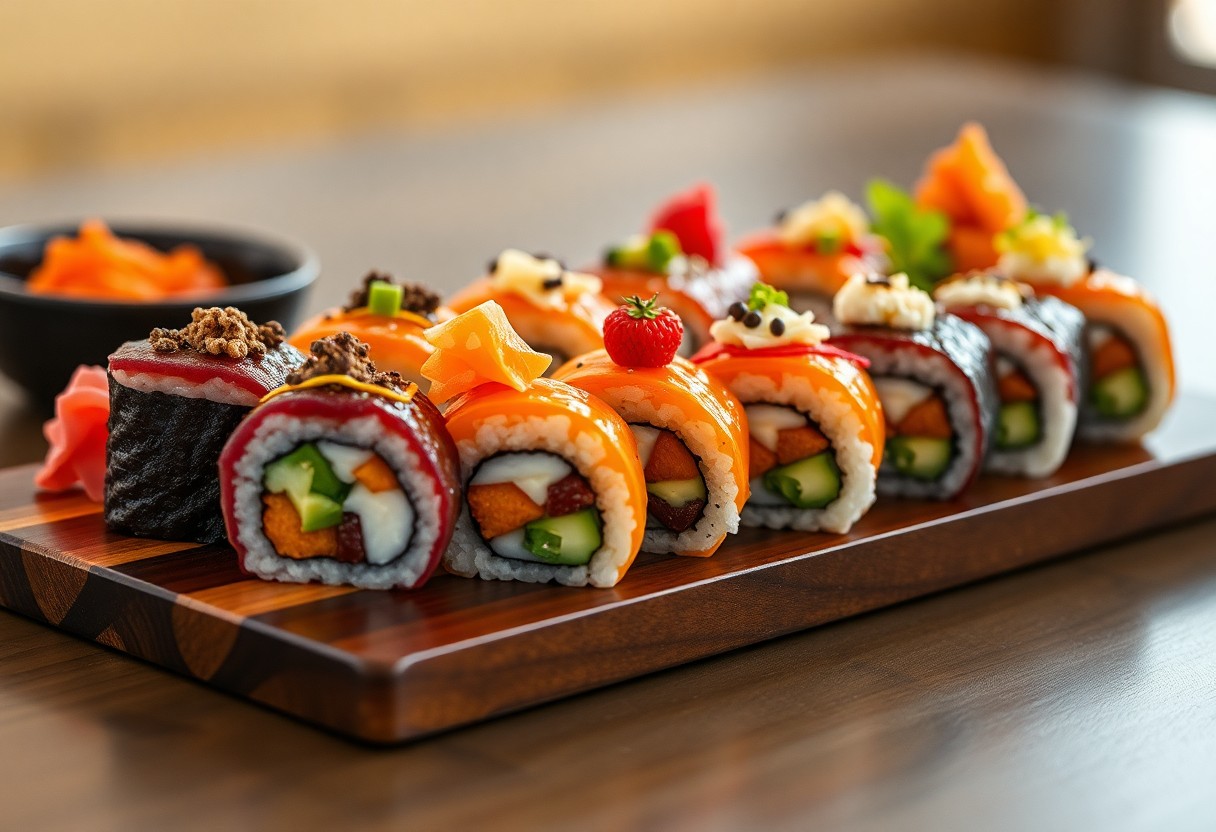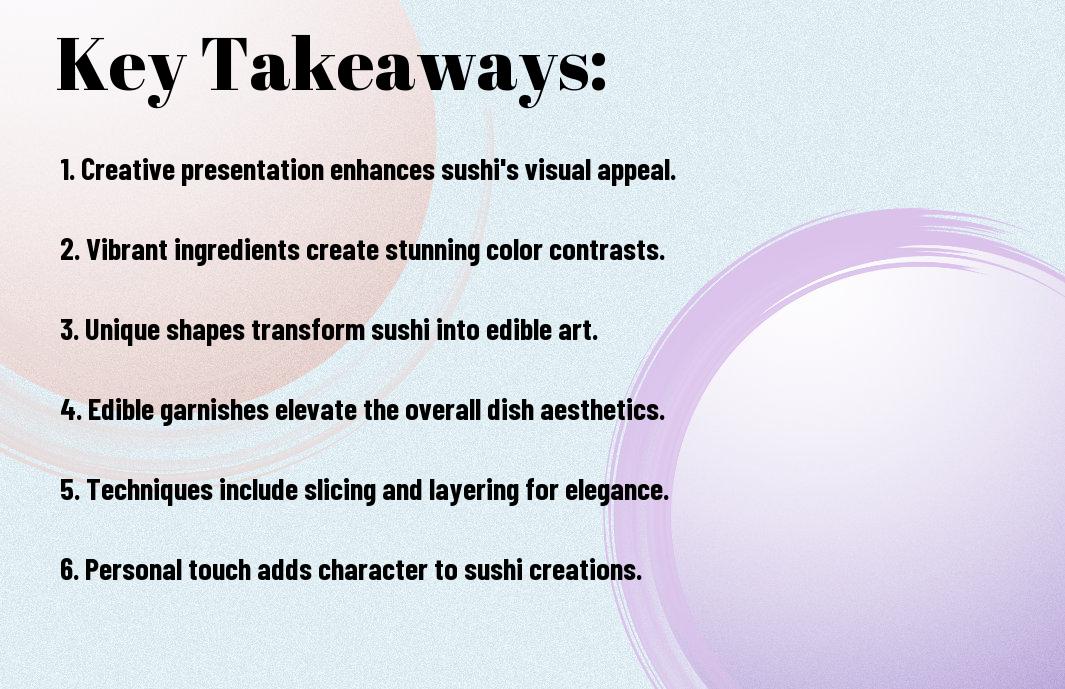Most sushi lovers might think that creating sushi at home is daunting, but you’ll discover it can be an enjoyable and rewarding culinary adventure. With just a few ingredients and some basic techniques, you can craft unique and delicious sushi rolls tailored to your taste. This guide will introduce you to a variety of creative sushi roll ideas that are both easy to prepare and impressive to serve, ensuring that you can bring a touch of Japan to your kitchen.
Key Takeaways:
- Ingredients Variety: Experiment with different types of fish, vegetables, and even fruits to create unique and flavorful rolls.
- Rolling Technique: Master the proper rolling technique to ensure your sushi holds together, using a bamboo mat for best results.
- Sauces and Toppings: Enhance flavors with a range of sauces, toppings, and garnishes like spicy mayo, eel sauce, or sesame seeds.
- Presentation: Focus on the presentation of your sushi rolls, using colors and shapes to make them visually appealing.
- Health Benefits: Homemade sushi allows you to control ingredients, making it a healthier choice than takeout options.
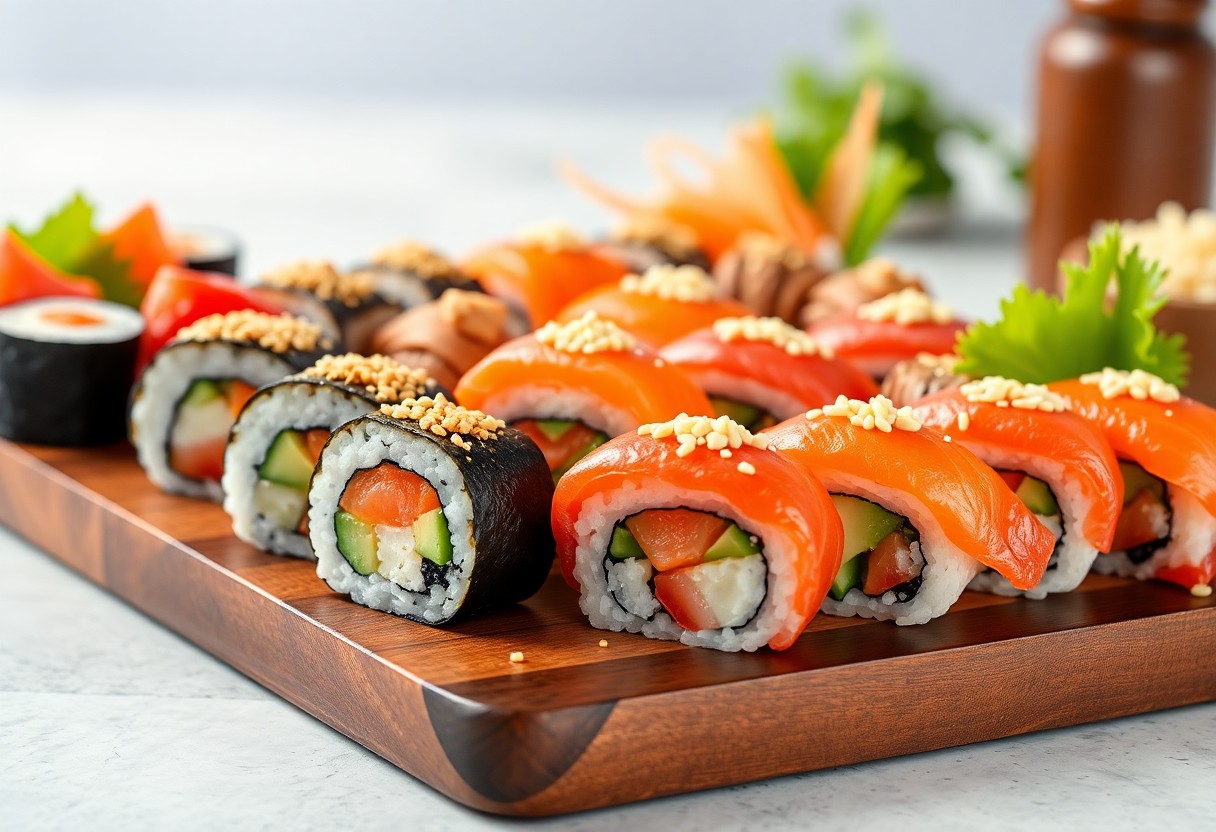
Essential Ingredients for Sushi Rolls
The right ingredients can elevate your sushi rolls from simple to spectacular. To create delicious sushi at home, you’ll need a few key items: sushi rice, fresh fish or seafood, seaweed sheets, and various fillings and toppings. Having these vitals on hand makes it easier to unleash your creativity and experiment with flavors.
Types of Sushi Rice
One of the most important elements of sushi rolls is the rice. The two primary types of sushi rice are:
| Type | Description |
| Short Grain | Sticky and ideal for sushi rolls. |
| Medium Grain | Fluffier texture, good for poke bowls. |
| Brown Rice | Nutty flavor, healthier option. |
| White Rice | Traditional choice for sushi. |
The right rice will provide the perfect foundation for your sushi creations.
Fresh Fish and Seafood Options
Any great sushi roll features fresh fish or seafood as the star. Look for options like tuna, salmon, or shrimp to enhance the flavor of your rolls.
Rolls made with fresh fish or seafood are not only delicious but also packed with nutrients. You have the freedom to choose from various types of fish, including sashimi-grade fish for that melt-in-your-mouth experience. Don’t shy away from trying seafood varieties like crab or scallops to bring unique textures to your sushi rolls.
Vegetarian Alternatives
Seafood lovers aren’t the only ones who can savor sushi; there are amazing vegetarian alternatives too. Using vegetables and plant-based proteins can create a satisfying sushi experience.
Further exploration into vegetarian options opens up an array of flavors and textures. Ingredients like avocado, cucumber, and roasted sweet potato can be delicious fillings, while tempeh or tofu offers protein-rich choices. Embrace the versatility of vegetarian sushi to impress everyone at your dinner table.
Unique Fillings and Toppings
At the heart of creativity in sushi making are unique fillings and toppings. You can use everything from spiced mayonnaise to pickled vegetables to elevate your rolls.
In addition, consider experimenting with unconventional ingredients like mango, jalapeños, or even cream cheese. These additions can enhance your sushi’s flavor profile, making your homemade sushi not just a meal but a delightful culinary adventure.
Sushi Rolling Techniques
If you’re looking to master sushi rolling at home, you’ll need to understand the basics. The art of sushi rolling combines technique and creativity to create beautiful, tasty rolls. By using the right approach and practicing regularly, you can enhance your skills and develop unique variations that suit your taste. Dive into various methods and techniques to bring your sushi to life!
Tools You’ll Need
Against a backdrop of endless culinary possibilities, having the right tools can make all the difference in your sushi-making journey. Equip yourself with a bamboo sushi mat, sharp knife, rice cooker, and sushi rice to ensure that your rolling experience is both enjoyable and efficient.
Step-by-Step Rolling Guide
Below are some imperative steps to follow for perfect sushi rolls. These instructions will guide you through the process, ensuring a successful and delicious sushi experience.
| 1. Prepare your ingredients | Gather your sushi rice, fillings, and nori (seaweed). |
| 2. Spread the rice | Evenly spread a layer of sushi rice over the nori. |
| 3. Add your fillings | Place your desired fillings across the center of the rice. |
| 4. Roll tightly | Using the bamboo mat, roll the sushi away from you, applying gentle pressure. |
| 5. Slice and serve | Cut the roll into even pieces and serve with soy sauce. |
Rolling sushi may seem daunting at first, but with practice and a few guidelines, you’ll find it becomes second nature. Start by preparing your ingredients carefully, ensuring your fillings are balanced and fresh. Utilize the bamboo mat to help you roll tightly without squeezing too hard. The more you roll, the more comfortable you’ll become with the technique, allowing you to experiment with different ingredients and styles over time!
| Use cold water | Dampen your hands when handling rice to prevent sticking. |
| Experiment | Try different fillings and sauces to discover what you love. |
Creative Sushi Roll Recipes
After exploring the world of sushi, you’ll find countless creative rolls that are not only delicious but also fun to make at home. These unique recipes will inspire you to experiment with flavors and ingredients, allowing you to customize your sushi experience according to your taste. Let’s explore some imaginative takes on classic sushi rolls that you can easily prepare in your own kitchen.
California Roll with a Twist
Against the traditional California roll, this variation incorporates spicy crab salad and fresh cucumber, all wrapped in a layer of avocado and drizzled with a tangy ponzu sauce. By replacing the standard imitation crab with real crab or even shrimp, you’ll elevate the flavor and take this roll to new heights.
Spicy Tuna Avocado Roll
Between the layers of sushi rice and nori lies a bold combination of raw tuna and creamy avocado, creating a rich yet refreshing bite. This roll not only delivers on taste but also provides a delightful texture that you’ll enjoy with each mouthful.
Sushi aficionados will love the Spicy Tuna Avocado Roll for its perfect balance of heat and creamy texture. You can amp up the spice by adding a dash of Sriracha or chili mayo to the tuna mixture. Using fresh, high-quality tuna is crucial for achieving that melt-in-your-mouth experience. Enhance your roll with a sprinkle of sesame seeds or sliced green onions for extra flavor and a pop of color. You’ll find this roll to be a satisfying addition to your sushi repertoire!
Tempura Veggie Roll
California dreaming finds a new expression in the Tempura Veggie Roll, featuring a delightful mix of tempura-fried vegetables like sweet potato, zucchini, and bell peppers. Wrapped in sushi rice, this roll offers a crunchy exterior with a savory filling, making it perfect for both vegetarians and seafood lovers alike.
The Tempura Veggie Roll brings a satisfying crunch to your sushi creations. By lightly frying your chosen vegetables, you add a layer of texture that contrasts beautifully with the soft sushi rice. You can experiment with different vegetables to suit your palate, whether it’s carrot, asparagus, or even eggplant. For a finishing touch, serve this roll with soy sauce or a homemade dipping sauce, creating a flavorful treat that’s sure to impress your guests.
Mango and Cream Cheese Roll
Mango wraps itself around luscious cream cheese and fresh cucumbers in this innovative roll that balances savory and sweet flavors. This combination creates a surprising yet delightful twist that will have your taste buds dancing with joy.
Further enhancing the Mango and Cream Cheese Roll, you can also add slices of crunchy almonds or toasted coconut for added texture. This roll is perfect for those hot summer days when you crave something light and refreshing. Drizzle a bit of honey or citrus sauce over the top to amplify the sweetness, making this roll not just a treat for your palate but also a visually stunning presentation on your sushi platter.
Serving and Presentation Tips
Many factors contribute to a stunning sushi presentation that impresses your guests. Consider these serving tips to elevate your homemade sushi rolls:
- Use a bamboo sushi mat for uniform shapes.
- Slice your rolls with a sharp knife for clean edges.
- Serve on a decorative platter or plate.
- Incorporate colorful garnishes for visual appeal.
- Label your rolls for a fun and interactive experience.
Assume that aesthetics enhance not only taste but also the dining experience.
Plating and Garnishing Ideas
Before you serve your sushi rolls, think about how to make them visually appealing. Choose a contrasting plate color to showcase the vibrant hues of your sushi. Consider garnishing with sliced avocado, edible flowers, or microgreens to add a touch of elegance. You can also sprinkle sesame seeds or drizzle spicy mayo to complement the rolls aesthetically.
Pairing with Dipping Sauces
Tips for choosing dipping sauces can enhance the overall sushi experience. Opt for traditional soy sauce, spicy mayo, or a tangy ponzu to elevate your flavors. Testing various combinations can surprise you and your guests with unique pairings.
And, it’s beneficial to consider the flavors of your sushi rolls when pairing with sauces. For instance, if your roll includes spicy elements, a hint of sweet eel sauce can balance the heat. Likewise, citrus-based sauces like yuzu can complement fresh fish. Don’t hesitate to experiment with different sauces to discover the perfect match for each roll, enhancing both taste and enjoyment.
Common Mistakes to Avoid
Once again, avoiding common mistakes can elevate your sushi-making experience. Some pitfalls can lead to disappointing results, so it’s important to be aware of them. Missteps in preparation, cooking, and rolling can affect the flavor and texture of your sushi rolls, so keeping these in mind will help you create sushi that tastes just as good as what you’d find in a restaurant.
Sushi Rice Cooking Errors
Common errors in cooking sushi rice can ruin your entire dish. Not rinsing the rice properly can lead to excess starch and gummy texture. Always soak the rice for the right amount of time before cooking, and ensure you use the correct rice-to-water ratio to achieve that perfect sticky consistency.
Improper Rolling Technique
By using the right rolling technique, you can significantly enhance your sushi rolls. A common mistake is applying too much pressure while rolling, which can squash your ingredients and create a poor final product. Instead, aim for a gentle yet firm roll, allowing your ingredients to be snug without being overly compressed.
Cooking with the proper technique involves holding your sushi mat and rolling firmly yet gently. Start by placing your sushi ingredients on the rice-topped nori, keeping them towards the edge. Invest time in mastering the motion—begin by folding the mat over the filling and then rolling away from you. The key is to maintain even pressure and avoid squeezing too tightly, which can lead to an unappetizing mush. A good roll showcases the vibrant colors and textures of your fillings, inviting everyone to take a bite!
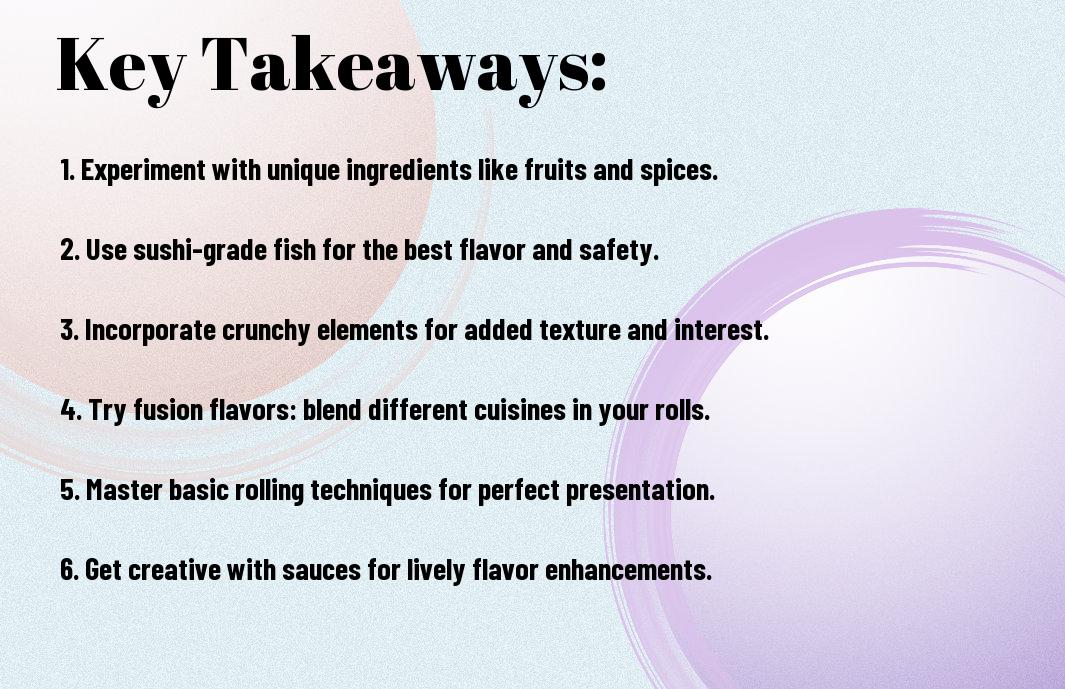
To wrap up
Upon reflecting, you can elevate your culinary skills by exploring the world of creative sushi rolls at home. By experimenting with various ingredients, flavors, and techniques, you can craft unique rolls that cater to your personal taste. This not only enhances your cooking repertoire but also offers a fun and engaging way to entertain family and friends. For inspiration and step-by-step guides, check out these Sushi Roll Recipes to help you get started on your sushi-making journey.
FAQ
Q: What are some easy ingredients to use for making creative sushi rolls at home?
A: When making sushi rolls at home, you can get creative with a variety of ingredients. Start with sushi rice, which acts as the base. Common fillings include cucumber, avocado, and imitation crab. For a twist, consider using grilled shrimp, tempura vegetables, or sliced fruits like mango or pineapple. You can also add sauces such as spicy mayo or teriyaki for extra flavor. Don’t forget to experiment with toppings like sesame seeds or even crushed chips for added texture!
Q: How can I make vegetarian sushi rolls that are flavorful?
A: Vegetarian sushi rolls can be incredibly tasty and vibrant. Start with a base of sushi rice and nori seaweed. Fill your rolls with a variety of fresh vegetables such as bell peppers, carrots, and avocado. You could also include marinated mushrooms for an umami kick or roasted sweet potatoes for sweetness. Adding flavored cream cheese or pickled vegetables can also enhance the taste. Don’t hesitate to experiment with herbs like cilantro or mint to bring an extra layer of flavor.
Q: What is the best way to roll sushi at home without making a mess?
A: To roll sushi neatly at home, it’s important to prepare beforehand. Start by laying a bamboo sushi mat on a flat surface. Place a sheet of nori on the mat, shiny side down. Wet your hands with a mixture of water and a little rice vinegar to prevent sticking, then spread an even layer of sushi rice over the nori. When adding fillings, avoid overstuffing, as this will make rolling difficult. Tightly roll the mat while applying gentle pressure, and seal the edge of the nori with a touch of water. Use a sharp knife to slice the rolls, cleaning it between cuts for clean edges.
